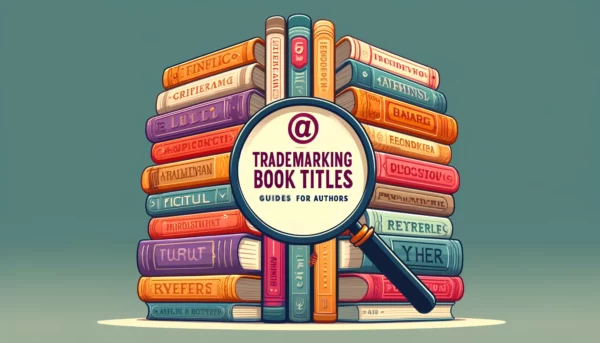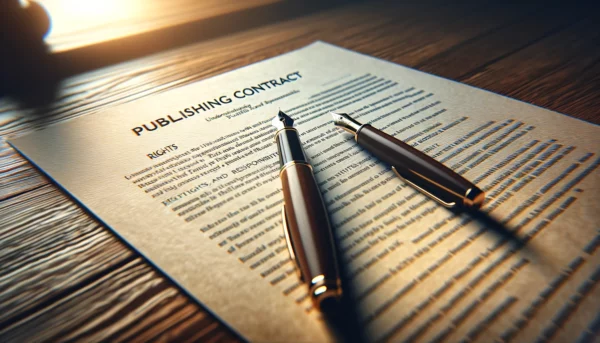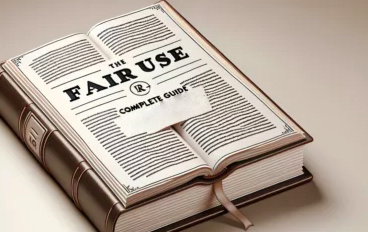In the literary world, a book title is more than just a name; it’s a unique identifier that distinguishes one author’s work from another’s and plays a critical role in branding and marketing. For authors, the decision to trademark a book title is an essential consideration in protecting this unique aspect of their creative work. Trademarking a book title can offer legal protection against misuse or duplication, ensuring that the title remains exclusively associated with the author’s work. This process not only safeguards the author’s rights but also reinforces the book’s market identity, preventing confusion among readers and maintaining the integrity of the author’s brand.
This introduction to trademarking book titles will guide authors through the fundamental steps of securing a trademark, highlighting its significance in the broader context of copyright protection and intellectual property rights in the publishing industry.
Step 1: Understanding the Basics of Trademark Law
Trademark law serves as the foundation for protecting brand names, logos, and other distinctive signs that identify and distinguish goods or services in the market. At its core, trademark law is designed to prevent consumer confusion by ensuring that one party cannot use a mark so similar to another’s that it could mislead the public about the source or origin of the goods or services.
Your Publishing Journey Awaits – Start NowApplication of Trademark Law
When it comes to book titles and creative works, the application of trademark law is nuanced. Generally, the title of a single book is not eligible for trademark protection because it does not meet the requirement of identifying the source of a series of works. Trademark protection is more commonly granted to series titles—such as “Harry Potter” or “The Magic School Bus”—where the title serves to brand a series of books, for example by making it clear that they come from the same source and distinguishing them from works by other authors.
The rationale behind this approach is that a single work’s title, like a novel or an individual poem for example, is considered too specific to a single creative work to function as a source identifier in the marketplace. However, when the same name or title is used across multiple works, it creates a brand that signifies a series of works with a common origin, the titles thus becoming eligible for trademark protection.
Authors and creators looking to grant trademark rights for their book titles should understand this distinction, as it plays a crucial role in determining the eligibility for trademark protection. Additionally, it’s important to recognize that trademark law is intended to prevent confusion among consumers, protect the interests of creators, and promote fair competition by ensuring that trademarks are not used in ways that could mislead or deceive consumers about the origin or quality of a product or service.
Step 2: Assessing the Need for a Trademark
For authors contemplating trademark protection for their book titles, assessing the need for a trademark is a critical first step. Not every book title necessitates trademark registration, but certain factors can signal the potential benefit of securing a trademark. The primary consideration is the uniqueness and distinctiveness of the title. A title that is generic or commonly used in the literary world may not qualify for trademark protection due to a lack of distinctiveness. On the other hand, a unique and distinctive title, especially one that carries the potential to be developed into a book series, or brand, may be a strong candidate for trademark protection.
Another crucial factor is the author’s long-term vision for their work. If the title is intended to be the cornerstone of a series, with subsequent books, merchandise, or adaptations (such as films or TV shows) planned, trademark protection can help maintain the integrity and exclusivity of the brand associated with the series title. This ensures that the title remains closely linked to the author’s original work and cannot be exploited by others in a way that might dilute its value or mislead consumers.
Additionally, authors should consider the potential for their title to be used in a broader commercial context beyond just the book itself. If there’s a likelihood that the title could be used on merchandise, in educational programs, or within other media, securing a trademark can provide a level of control and legal recourse against unauthorized use. Assessing these factors helps authors make an informed decision about whether pursuing trademark protection for their book title is a strategic move for their career and their creative work’s longevity.
Step 3: Conducting a Preliminary Trademark Search
Before proceeding with a trademark application, conducting a preliminary trademark search is an essential step for authors. This search aims to uncover any existing trademarks that could potentially conflict with the proposed book title, reducing the risk of infringement issues or application rejections. Here are the steps to conduct an effective preliminary trademark search:
1. Start with a Basic Internet Search: Begin by entering your book title into popular search engines. This broad search can reveal immediate conflicts and give you an insight into the usage of similar titles in the market. Pay attention to businesses, products, or other books that might be using a similar name.
2. Use the USPTO’s Trademark Electronic Search System (TESS): The United States Patent and Trademark Office (USPTO) provides a free database called TESS, where you can search registered trademarks and pending trademark applications. When using TESS, search for your exact title and variations of it, including phonetic equivalents and similar-sounding names. This can help identify direct hits and similar marks that might pose a conflict.
3. Look Beyond Exact Matches: A trademark doesn’t have to be identical to yours to be considered a conflict. Trademarks that are deemed confusingly similar, in sound, appearance, or meaning, can for legitimate reasons also pose issues. Consider variations in spelling, synonyms, and foreign language equivalents of your title during your search.
4. Assess the Goods and Services: Pay attention to the categories (classes) in which existing trademarks are registered. A trademark for a similar title might exist, but if it’s registered under a completely different category that doesn’t relate to books or publishing, it may not pose a conflict. However, closely related categories that might include entertainment, education, or digital publications should be scrutinized.
5. Document Your Findings: Keep a record of your search process and the results. This documentation can be useful if any questions arise during the trademark application process about the thoroughness of your preliminary search.
If this preliminary search reveals significant potential conflicts, it might be wise to reconsider your title or consult with a trademark attorney to evaluate the findings. However, if no obvious potential conflicts emerge, you can proceed with a more detailed search, potentially with professional assistance, to further ensure the viability of your chosen book title for trademark registration.
Your Publishing Journey Awaits – Start NowStep 4: Engaging a Trademark Attorney
Engaging a trademark attorney can significantly enhance the likelihood of successfully trademarking a book title, as they bring expertise in navigating the complexities of trademark law. When selecting a trademark attorney, consider their experience in trademark law, particularly with creative works like book titles. Look for professionals with a track record of working with authors or in the publishing industry, as they will have a nuanced understanding of the challenges and requirements specific to literary works.
A trademark attorney can assist in several key areas of the trademarking process:
1. Conducting a Comprehensive Trademark Search: While a preliminary internet search can be done independently, a trademark attorney will conduct a more thorough search, including databases that may not be accessible to the public. They have the tools and knowledge to evaluate not only direct conflicts but also nuanced similarities that could pose risks.
2. Evaluating the Strength of Your Trademark: An attorney can assess the distinctiveness and potential registrability of your book title, advising on any changes that might enhance its strength as a trademark. They can identify any elements that might make the book’s title seem too generic or descriptive, which are typically not protectable under trademark law.
3. Navigating the Application Process: Filing a trademark application involves more than just filling out forms. A trademark attorney can help in accurately identifying the correct classifications for your trademark, describing the goods and services, and crafting a strategic filing that maximizes the chances of approval.
4. Addressing Legal Issues: Should any legal issues arise, such as an office action from the USPTO or a conflict with an existing trademark, your attorney can respond effectively, arguing the case for your trademark’s registration.
5. Advising on Use and Enforcement: Beyond registration, a trademark attorney can provide guidance on how to properly use your trademark to maintain its protection and can provide evidence on how to enforce your rights if infringement occurs.
Choosing the right trademark attorney is a crucial step in securing a trademark for your book title. Their expertise not only facilitates the application process but also provides a foundation for the ongoing protection of your creative work.
Your Publishing Journey Awaits – Start NowStep 5: Filing the Trademark Application
Filing a trademark application for a book title involves several detailed steps, requiring careful preparation and attention to ensure accuracy and completeness. Here’s a step-by-step guide to navigating this process:
1. Prepare the Necessary Information: Before you begin the application, gather all the required information. This includes the exact name you wish to trademark, a clear description of the goods or services associated with the trademark (in this case, the type of book title trademarks, of literary works), and, if already in use, the date of first use in commerce. For a book title, you will also need to specify whether it’s for a single book or a series.
2. Decide on the Application Basis: If you have already used your book title in commerce, you can file based on “actual use.” If you plan to use it in the future, you can file based on “intent to use.” This distinction is important as it affects the requirements and the next steps in the process.
3. Create or Log in to Your USPTO Account: The United States Patent and Trademark Office (USPTO) requires you to fill out your application through their online system. If you don’t already have an account, you’ll need to create one.
4. Complete the Application Form: The USPTO’s online system will guide you through the application form. Be precise when describing your book title and the nature of your goods or services to avoid broad claims that could lead to rejections. You’ll also need to choose the appropriate class for your goods or services—books typically fall under Class 16 (Printed Matter), but other classes may apply if your title will be used on different products or particular goods or services.
5. Submit Specimens: If you are filing based on actual use, you need to submit specimens showing your book title in use. This could be a photo of the book cover, a screenshot of an online bookstore where it’s sold, or marketing materials featuring the title.
6. Review and Submit the Application: Carefully review your application for any errors or omissions. The USPTO does not refund filing fees for incorrect or incomplete applications. Once satisfied, submit the application along with the required filing fee. Fees vary based on the number of classes of goods or services and the application basis.
7. Monitor the Application: After submission, you can monitor the status of your application through the USPTO’s online system. Be prepared to respond to any communications from the USPTO, such as requests for additional information or clarifications.
By meticulously preparing and submitting your trademark application, you can enhance the likelihood of securing trademark protection for your book title, safeguarding more protection for your rights, and reinforcing your brand in the literary marketplace.
Step 6: Responding to the USPTO’s Actions
Responding to actions from the United States Patent and Trademark Office (USPTO) is a critical part of the trademark application process. After you submit your application, an examining attorney at the USPTO will review it to ensure compliance with all legal requirements. If the examining attorney identifies any issues, they will issue an “office action,” a formal communication outlining the reasons your application cannot proceed as filed. Here’s how to effectively address these actions:
1. Understand the Office Action: Office actions can range from simple requests for additional information to substantive refusals based on the likelihood of confusion with existing trademarks or the descriptiveness of the mark. It’s crucial to thoroughly understand the nature of the objections or requests raised by the examining attorney.
2. Don’t Ignore the Deadline: Office actions come with a strict response deadline, typically six months from the date of issuance. Failing to respond by the deadline can result in the abandonment of your application. It’s important to act promptly.
3. Consult with Your Trademark Attorney: If you’re working with a trademark attorney, discuss the office action with them. They can provide expert guidance on the best course of action, whether it involves arguing against the refusal, amending the application, or providing the requested additional information.
4. Prepare a Comprehensive Response: Your response should directly address each issue raised in the office action. If the examining attorney has requested additional information, provide it clearly and concisely. If your application has been refused based on substantive grounds, you may need to argue why the refusal should be reconsidered, which might involve legal arguments, additional evidence, or amendments to the application.
5. Submit the Response: Once your response is prepared, submit it through the USPTO’s online system before the deadline. Ensure that your response is complete and addresses all the points raised in the office action to avoid further delays.
6. Follow Up if Necessary: After submitting your response, monitor the status of your application. The examining attorney may issue a final office action if they find your response insufficient, at which point you may need to consider further arguments, appeals, or alternative strategies.
Effectively responding to USPTO actions is essential for advancing your trademark application toward registration. It requires careful attention to detail, a clear understanding of trademark law, and, often, the expertise of a qualified trademark attorney.
Your Publishing Journey Awaits – Start NowStep 7: Finalizing the Trademark Registration
Once your trademark application successfully overcomes any USPTO office actions and is approved by the examining attorney, it moves into the final stages of the registration process. These steps are crucial to officially secure your trademark rights:
1. Notice of Publication: The USPTO will issue a Notice of Publication, indicating that your trademark will be published in the Official Gazette, a weekly publication of the USPTO. This publication step is essential, as it informs the public of your pending trademark registration, allowing any parties who believe they may be harmed by the registration of your mark to file an opposition.
2. Opposition Period: Following publication in the Official Gazette, there is a 30-day period during which any party can file an opposition to your trademark registration. Oppositions are typically filed by parties who believe that the registration of your mark would infringe upon their trademark rights or cause confusion in the marketplace.
3. Dealing with Opposition: If an opposition is filed, it initiates a legal proceeding before the Trademark Trial and Appeal Board (TTAB). You will have the opportunity to respond and defend your trademark application. This process can be complex and may require legal representation to navigate effectively.
4. Registration Certificate: If no opposition is filed, or if you successfully overcome any opposition, the USPTO will issue a Registration Certificate for your trademark. This certificate is your official documentation of trademark ownership, providing legal evidence of your exclusive right to use the mark in connection with the goods or services listed in your application.
5. Maintaining Your Trademark: Remember, trademark registration is not the end of the process. You must maintain your trademark by using it consistently in commerce and filing the necessary maintenance documents with the USPTO at specific intervals to keep your registration active and enforceable.
By navigating these final steps carefully, you can ensure the successful registration of your trademark, securing the legal protections it offers for your book title and associated works.
Step 8: Maintaining and Enforcing Your Trademark
Securing a trademark for your book title is a significant achievement, but it’s only the beginning of an ongoing process of maintenance and enforcement to ensure your trademark’s value and protection remain intact.
Monitoring for Infringement
- Regular Searches: Regularly conduct online searches for your trademarked book title to ensure it’s not being used without authorization. This includes checking book retailers, social media, and domain registrations.
- Google Alerts: Set up Google Alerts for your trademarked title to receive notifications of new online mentions, which can help in identifying potential infringements quickly.
- Watch Services: Consider using trademark watch services that can monitor the use of your trademarked title and alert you to potential infringements.
Renewing the Trademark
- Understand the Timeline: U.S. trademarks need to be renewed between the 5th and 6th year after registration and subsequently every 10 years. Missing these deadlines can result in the cancellation of your trademark.
- File the Required Declarations: For the first renewal, you must file a “Declaration of Use” and/or “Excusable Nonuse” between the 5th and 6th year. For subsequent renewals, a “Combined Declaration of Use and Application for Renewal” must be filed every 10 years.
- Maintain Accurate Records: Keep detailed records of your trademark use in commerce, as this evidence is crucial when filing renewal documents.
Enforcing Your Trademark
- Cease and Desist Letters: If you discover unauthorized use of your trademarked title, a cease and desist letter can be an effective first step. This letter formally requests the infringing party to stop using your trademarked title.
- Negotiation and Settlement: Sometimes, infringement issues can be resolved through negotiation, leading to a settlement that avoids costly legal proceedings.
- Legal Action: If infringement continues despite cease and desist letters and attempts at negotiation, legal action may be necessary. This can involve filing a lawsuit to enforce your trademark rights, seeking injunctive relief to prevent further infringement, and possibly claiming damages.
- Stay Proactive: The effectiveness of your trademark protection largely depends on your vigilance and willingness to enforce your rights. Regular monitoring, timely renewals, and decisive action against infringement are key to maintaining the strength and value of your trademarked book title.
- Maintaining and enforcing your trademark is an ongoing responsibility that requires attention and action. By staying proactive, you can protect the integrity of your trademarked book title and the brand it represents.
Conclusion
In conclusion, trademarking your book title is a strategic step to safeguard your creative work and establish a distinctive brand identity in the literary marketplace. By understanding the basics of trademark law, conducting thorough searches, engaging with a trademark attorney, and navigating the application process, authors can secure valuable legal protections for their individual book titles. With diligence in maintaining and enforcing their trademarks, authors can preserve the integrity of their creative works and mitigate the risk of unauthorized use or infringement. We encourage all authors to explore trademarking their book titles to protect their intellectual property and ensure long-term success.
If you’re looking to publish your book, Spines offers the simplest and fastest option for you. Sign up for free and start exploring your options today.







